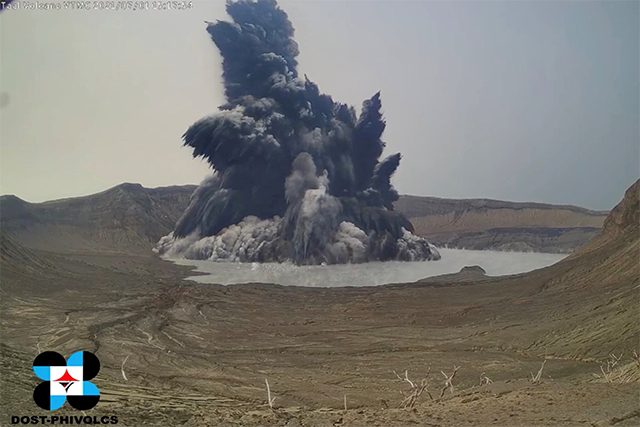
Does the sulfur dioxide that Taal Volcano emits has an effect to the current rainfall brought by the outgoing Tropical Depression “Emong”?
Disaster scientist Mahar Lagmay suggested on Twitter a quick science activity that kids and adults can do at home.
State seismologists have raised Taal volcano’s alert level from Level 2 (increasing unrest) to Level 3 (magmatic unrest) on July 1 after a phreatomagmatic eruption was observed at the main crater.
A video of it was shared on the social media accounts of the Philippine Institute of Volcanology and Seismology (PHIVOLCS-DOST).
Satellite data have also previously detected sulfur dioxide plumes from the volcano over Metro Manila and surrounding provinces.
Amid these coinciding natural events, Lagmay, also the director of Project NOAH (Nationwide Operational Assessment of Hazards), shared in a Twitter thread how Filipinos can measure the acidity of rains and determine if the sulfur dioxide plumes have made the rain in their areas acidic.
(1/3) Let’s engage our kids (or the curious person in you) with a real world scientific experiment. The project activity is to measure the acidity (pH) of rain in your backyard to determine if the SO2 emitted by Taal Volcano makes rain acidic in your area. #CitizenScience pic.twitter.com/waWxoToMo2
— Mahar Lagmay (@nababaha) July 5, 2021
All participants need is a clean glass or container to collect the rainwater and litmus paper, the scientist said. He noted that litmus paper can easily be purchased online.
“Procedure: Collect rainwater after every downpour then measure the acidity (pH) with litmus paper. Make sure to clean the glass after each acidity measurement from a rain event,” Lagmay said.
“Fill up the template and send to [email protected] That’s it pancit. We hope your kid enjoys this simple real-world experiment and be interested in science!” he added.
Lagmay also added that rainwater should be collected directly from the sky and not from their roofs.
“Oh we forgot this important note kids! Sorry about that. Note: Make sure the rainwater you collect comes directly from the sky and not from your roof gutter,” he said.
Lagmay shared this idea after the Twitter account Weather Manila shared the current situation of the plume through a gif on July 4.
“Taal plume was transported southward, then swirled along with the LPA’s circulation in Tayabas Bay. Tomorrow (July 5), the plume will be transported northward traversing NCR (National Capital Region. This model doesn’t include interaction with rain, which generally cleans the atmosphere,” read the tweet.
Today (4Jul) Taal plume was transported southward, then swirled along with the LPA’s circulation in Tayabas Bay. Tomorrow (5Jul), the plume will be transported northward traversing NCR. This model doesn’t include
interaction w/ rain, w/c generally cleans the atmosphere. pic.twitter.com/afUTM09p8E— WeatherManila (@Weather_Manila) July 4, 2021
In the replies, Lagmay asked if the plumes will make the rain acidic. Weather Manila responded that theoretically, it should.
“In theory, it will make rain acidic, pero short exposure lang naman for now so should not be big problem. As far as I know, walang nagme-measure ng ph ng rain na long-term, interesting sana Makita,” the account said.
In an advisory on the same day, PHIVOLCS observed an “anomalously high” sulfur dioxide emission from the volcano, citing it as the “highest ever recorded” from Taal.
“The highest levels of volcanic sulfur dioxide or SO2 gas emission was recorded today at an average of 22,628 tonnes/day, the highest ever recorded in Taal,” it said.
The state weather bureau, meanwhile, reported that Emong continues to move northwestward of Batanes-Babuyan Islands Area at 45 kilometers per hour.









